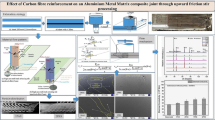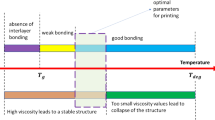Abstract
This paper presents a multi-material hybrid additive manufacturing process based on friction stir molding (FSM) for injection mold manufacturing. While a single material was utilized in FSM, herein functionally graded injection molds (FG molds) using FSM and multi-materials are manufactured. Two materials, brass 60/40 and AA5083 were used to demonstrate the process feasibility. A series of friction stir spot welding experiments were performed to identify suitable process settings. This included different combinations of rotational speeds and plunge rate of friction stir spot welding (FSSW) tool. The quality of testing coupons was examined by their shear loads and hardness profiles. ANOVA showed that only the plunge rate affects the quality of coupons and that the higher the plunge rate gives better quality. Two simple FG injection molds were manufactured and used to produce plastic parts based on the proper process settings. The FG molds produced parts with better quality compared to conventional steel molds which demonstrate the feasibility of the proposed process.
Access this article
We’re sorry, something doesn't seem to be working properly.
Please try refreshing the page. If that doesn't work, please contact support so we can address the problem.











Similar content being viewed by others
References
Campbell I, Bourell D, Gibson I (2012) Additive manufacturing: rapid prototyping comes of age. Rapid Prototyping J 18(4):255–258
Tompson MK, Moroni G, Vaneker TH, Fadel G, Campbell I, Gibson I, Martina F (2016) Design for additive manufacturing: trends, opportunities, considerations, and constraints. CIRP Ann Manuf Technol 65(2):737–760
Gibson I, Rosen DW, Stucker B, Khorasani M (2021) Additive manufacturing technologies, vol 17. Springer, Cham, Switzerland
Petrovic V, Vicente Haro Gonzalez J, Jordá Ferrando O, Delgado Gordillo J, Ramón Blasco Puchades J, Portolés Griñan L (2011) Additive layered manufacturing: sectors of industrial application shown through case studies. Int J Prod Res 49(4):1061–1079
Körner C (2016) Additive manufacturing of metallic components by selective electron beam melting—a review. Int Mater Rev 61(5):361–377
Dupláková D, Hatala M, Duplák J, Radchenko S, Steranka J (2018) Direct metal laser sintering–possibility of application in production process. SAR J 1(4):123–127
Katancik M, Mirzababaei S, Ghayoor M, Pasebani S (2020) Selective laser melting and tempering of H13 tool steel for rapid tooling applications. J Alloy Compd 849:156319
King D, Tansey T (2003) Rapid tooling: selective laser sintering injection tooling. J Mater Process Technol 132(1–3):42–48
Thompson MK, Moroni G, Vaneker T, Fadel G, Campbell RI, Gibson I, Martina F (2016) Design for additive manufacturing: trends, opportunities, considerations, and constraints. CIRP Ann 65(2):737–760
Merz R, Prinz FB, Ramaswami K, Terk M, Weiss LE (1994). Shape deposition manufacturing. In: 1994 international solid freeform fabrication symposium
Cormier D, Taylor J (2001) A process for solvent welded rapid prototype tooling. Robot Comp Integr Manuf 17(1–2):151–157
Zheng Y, Choi S, Mathewson B, Newman W (1996) Progress in computer-aided manufacturing of laminated engineering materials utilizing thick, tangent-cut layers. In: 1996 international solid freeform fabrication symposium.
Mueller B, Kochan D (1999) Laminated object manufacturing for rapid tooling and patternmaking in foundry industry. Comput Ind 39(1):47–53
Abdel-All ES, Frank MC, Rivero IV (2017) Rapid tooling using friction stir welding and machining. Rapid Prototyping J 23(1):81–95
Frank MC, Peters FE, Karthikeyan R (2010) Additive/subtractive rapid pattern manufacturing for casting patterns and injection mold tooling. In: 2010 International Solid Freeform Fabrication Symposium. University of Texas, Austin
Abdelall ES, Al-Dwairi AF, Al-Raba’a SM, Eldakroury M (2021) Printing functional metallic 3D parts using a hybrid friction-surfacing additive manufacturing process. Progr Additive Manuf 6:731–741
Sahasrabudhe H, Bose S, Bandyopadhyay A (2018) Laser-based additive manufacturing processes. In: Lawrence J (ed) Advances in laser materials processing. Woodhead Publishing, UK, pp 507–539
Yan Z, Liu W, Tang Z, Liu X, Zhang N, Li M, Zhang H (2018) Review on thermal analysis in laser-based additive manufacturing. Opt Laser Technol 106:427–441
Yin S et al (2018) Hybrid additive manufacturing of Al-Ti6Al4V functionally graded materials with selective laser melting and cold spraying. J Mater Process Technol 255:650–655
Kapil S, Legesse F, Negi S, Karunakaran KP, Bag S (2020) Hybrid layered manufacturing of a bimetallic injection mold of P20 tool steel and mild steel with conformal cooling channels. Progr Addit Manuf 5(2):183–198
Durejko T, Ziętala M, Polkowski W, Czujko T (2014) Thin wall tubes with Fe3Al/SS316L graded structure obtained by using laser engineered net shaping technology. Mater Des 63:766–774
Zhang Y, Bandyopadhyay A (2018) Direct fabrication of compositionally graded Ti-Al2O3 multi-material structures using laser engineered net shaping. Addit Manuf 21:104–111
Silvério S, Krohn H, Fitseva V, Alcântara NGD, Santos JFD (2018) Deposition of AA5083-H112 over AA2024-T3 by friction surfacing. Soldagem Inspeção 23:225–234
Ogunsemi BT, Abioye TE, Ogedengbe TI, Zuhailawati H (2021) A review of various improvement strategies for joint quality of AA 6061–T6 friction stir weldments. J Mate. Res Technol 11:1061–1089
Peel M, Steuwer A, Preuss M, Withers PJ (2003) Microstructure, mechanical properties and residual stresses as a function of welding speed in aluminum AA5083 friction stir welds. Acta Mater 51(16):4791–4801
Gao P, Zhang Y, Mehta KP (2021) Metallurgical and mechanical properties of Al–Cu joint by friction stir spot welding and modified friction stir clinching. Met Mater Int 27(8):3085–3094
Park HS, Kimura T, Murakami T, Nagano Y, Nakata K, Ushio M (2004) Microstructures and mechanical properties of friction stir welds of 60% Cu–40% Zn copper alloy. Mater Sci Eng, A 371(1–2):160–169
Funding
This research was funded by the Deanship of Research at Jordan University of Science and Technology, Grant No.20190036.
Author information
Authors and Affiliations
Corresponding author
Ethics declarations
Conflict of interest
On behalf of all authors, the corresponding author declares that there is no conflict of interest.
Additional information
Publisher's Note
Springer Nature remains neutral with regard to jurisdictional claims in published maps and institutional affiliations.
Rights and permissions
About this article
Cite this article
Abdelall, E.S., Hayajneh, M. & Almomani, M. Fabrication of functionally graded injection molds using friction stir molding process of AA5083/brass-laminated composite. Prog Addit Manuf 8, 169–177 (2023). https://doi.org/10.1007/s40964-022-00320-8
Received:
Accepted:
Published:
Issue Date:
DOI: https://doi.org/10.1007/s40964-022-00320-8




